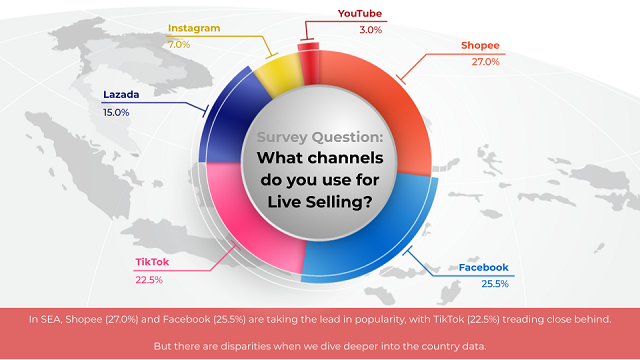Filipino sellers are among the most prolific live sellers with 47% doing it daily against a 31% regional average in Southeast Asia (SEA), a white paper from tech-enabled logistics firm Ninja Van Philippines said.

Ninja Van also said this is its first-ever white paper on live selling in the region. The company said the white paper introduces live selling as one of the up-and-coming SEA e-commerce trends, and shares live selling insights collected from over 1,000 Ninja Van’s e-commerce sellers across Singapore, Malaysia, Indonesia, The Philippines, Thailand, and Vietnam.
While still a nascent industry, nearly one in three surveyed sellers have tried live selling. Of those who are already live selling, 9 in 10 prefer to do it themselves, and only one in 10 tap influencers to do live selling for them. Filipino sellers are among the most prolific live sellers, with 47% doing it daily, against a 31% regional average in SEA, the paper said.
More Filipinos than their regional counterparts also believe that live selling brings in new business, with 74% saying that attracting new customers is a top driver for conducting live selling. A secondary driver would be to increase profit, with 52% of Filipino sellers saying live selling is more profitable than just posting items on marketplaces and apps.
“Live selling is an interesting marketing tactic for e-commerce sellers,” Winston Seow, chief marketing and enablement officer, Ninja Van Group, said. “It’s the only tactic that can fast-track shoppers’ purchase journeys from awareness straight to conversion. Live selling also gives e-commerce sellers the ability to build relationships at scale with their shoppers, both new and existing.”
Filipino sellers can spend up to 14 hours weekly conducting live selling sessions, versus a regional average of up to six hours. Most of the early adopters of live selling are from low-involvement product categories such as Fashion, Beauty & Personal Care, Food and Beverages, as well as Home and Living.
While Shopee (27.0%), Facebook (25.5%), and TikTok (22.5%) are ranked as the top three live selling channels, the close margins signal that the champion has yet to emerge in SEA. This could be explained by the fact that on average, the surveyed SEA e-commerce sellers use two channels for Live Selling, presumably to maximize their outreach to live shoppers.
Sellers also use live selling as a means to build deeper connections with consumers.
“Live selling allows us to easily and directly engage with our audience who have become regular viewers of our live sessions. We’ve also seen lower product return rates since we have started live selling,” said Nikka Arasa of Suniega Stainless Products Tradings, a stainless product manufacturer based in Nagcarlan, Laguna.
The white paper further explores the challenges of live selling, such as keeping live shoppers engaged, preparing on-set logistical requirements, as well as sales and post-sales arrangements, while providing recommended solutions.
Ninja Van Philippines plans to conduct their first-ever live seller accelerator program, designed to equip both new and would-be live sellers necessary skills and seed money to bridge their business to live selling platforms.




